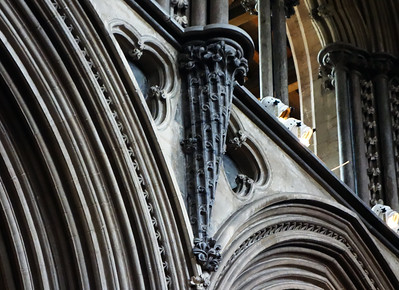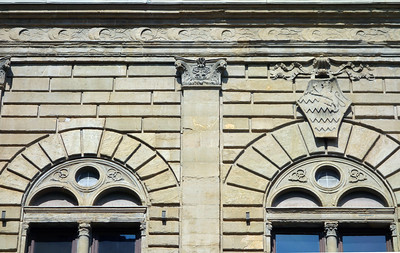adobe
Adobe buildings are typically earthen brick structures made of sand, silt, clay, and straw.
agora
An agora is an open, public space often in the heart of a city.
aisles
The aisles of a church are typically one or more narrower passageways flanking the nave.
ambulatory
An ambulatory is the circular hallway outside a central space.
Path or hall that allows a worshipper to circumambulate the temple.
apse
An apse is a recess at the end or side of a building. It is commonly semicircular and is often topped with a half dome.
An apse is a a large semicircular recess in a church, typically located at the eastern end and usually containing the altar.
An apse is a semicircular recess in a church.
An apse is a semicircular recess, usually terminating the longitudinal axis of a church, containing the altar.
An apse is a semicircular recess, usually terminating the longitudinal axis of a church, containing the altar.
aqueduct
An aqueduct is a structure built to convey water. The Romans constructed aqueducts throughout their Empire, to bring water from outside sources into cities and towns.
arcade
An arcade is a row of arches supported by columns.
arcosolium
An arcosolium is an arched burial niche.
baptisteries
A baptistery is a building or room containing a font for Christian initiation.
In this case, a baptistery is a building next to a church, used for baptism.
A baptistery is the place in which baptism takes place.
basilica
A basilica, in this case, refers to a Christian church whose plan echoes the older the ancient Roman civic basilica, a multipurpose public building type.
Based on ancient Roman architecture, a basilica is a rectangular building with long central hall, often flanked by aisles.
basilica the basilica is a church type based on Roman assembly halls, usually composed of a longitudinal nave flanked by side aisles
Here the word “basilica” refers to a long rectangular building with an apse (niche) at one end, an architectural form borrowed from ancient Rome and then widely used for Christian churches in the West.
A basilica is a building with a long central aisle, sometimes with a shorter wing crossing it, forming the shape of a cross.
The basilica is a church type based on Roman assembly halls, usually composed of a longitudinal nave flanked by side aisles.
The basilica is a church type based on Roman assembly halls, usually composed of a longitudinal nave flanked by side aisles.
basilica plan of a Romanesque church (Saint-Sernin, Toulouse, France, c. 1080-1120
Bays
sections distinguished by columns or pillars.
A bay is a space defined by two vertical architectural supports, such as piers, columns or ribs.
belfry
A belfry is a church steeple housing bells.
blind arcades
A blind arcade is one that is applied directly to the surface of a wall, so that the spaces between the arches are filled in.
An arcade is series of arches supported by piers or columns: when applied to the surface of a wall as decoration it is called a blind arcade
blind arches
A blind arch is one where the space of the arch is filled in.
campanile A campanile is a free-standing bell tower.
cathedral
A cathedral is the official seat of a bishop.
A cathedral is a church that is also the seat of a bishop.
cella
A cella is an interior chamber of an ancient Greek temple.
chancel
The chancel is the area of the church set aside for the clergy and altar.
The chancel is the area in which the altar was found.
chapter houses
A chapter house is a room in a monastery where monks gather.
chapter houses A chapter house is a room in a monastery where monks gather.
Charterhouse
A charterhouse, or chartreuse in French, is a term used to describe a Carthusian monastery.
clerestory
A clerestory is the uppermost part of the wall of a church, often punctuated by a row of windows.
The clerestory is a row of windows under the roof lighting the central space of a building.
The clerestory is the upper story of an elevation, with window openings
clerestory windows Clerestory windows are located high on the walls of a church, often above the side aisles and just below the ceiling of the central space.
cloister
A cloister is a covered walkway, typically in the form of an arcade surrounding a courtyard.
Composite
The Composite order is a combination of Ionic and Corinthian orders. The Corinthian order is characterized by acanthus leaf motifs on the capitals of the columns.
compound piers
A compound pier is a solid, load-bearing support made up of a central mass with one or more columns or shafts attached to it.
corbel
corbeling
Corbeling involves building by projecting slabs of stone beyond the length of the slab immediately below.
cornice
A cornice is the decorative molding at the edge of the roof
A cornice is an architectural element that projects from the top of a wall, either where a wall meets the ceiling, or at the top edge of the exterior of a building.
cruciform
Cruciform refers to something that is cross-shaped.
crypt
A crypt is an underground area of a church that holds burials.
dais
A raised platform.
dentils
Small, rectangular blocks that resemble teeth and used as a decoration.
Dentils are mall, rectangular blocks that resemble teeth and used as a decoration.
diaper-work
Diaperwork is a carved surface ornamentation formed by repeated geometrical motifs.
diaphragm arches
Diaphragm arches stand perpendicular to the nave, or main section of the church, dividing it into segments or bays.
entablature
The entablature is the horizontal area carried by the columns.
The entablature is a raised, horizontal element supported by columns or a wall.
The entablature is the horizontal area carried by the columns.
entasis
Entasis refers to a slightly convex curve in the shaft of a column, used to correct the visual illusion of concavity that occurs with straight shafts.
galleries
A gallery is a covered walkway found on upper stories of a building.
The gallery is the upper level in a church, above the side aisles and narthex, where worshippers could participate in church services.
The gallery is the upper level in a church, above the side aisles and narthex, where worshippers could participate in church services.
A gallery is an open walkway looking onto a central space.
A gallery is a space above an aisle that is open to the nave on one side.
great houses
A great house is a large, multi-storied Ancestral Puebloan structure.
groin vaults
A groin vault is a type of ceiling made from intersecting arches and often strengthened by added strips of stone (ribbing).
loculus
A loculus is a horizontal, rectangular burial niche.
loggia
In this case, “loggia” refers to a long open-air corridor in the Apostolic Palace.
mission church
A Mission is an effort to spread the Christian faith. Missions often involve sending individuals or groups (called “missionaries”) across geographical boundaries to convert people to Christianity. Missionaries often establish churches to help them in this work.
naos
The naos is the main body or nave of a Byzantine church.
narthex
Typical of early Christian and Byzantine architecture, the narthex, at the west end, is a vestibule before the entrance to a church.
nave
A nave is a narrow, elongated hall which functions as the main gathering area of a church.
The nave is the area of the church used to accommodate the congregation, usually located to the west.
The nave is the central aisle of a basilica.
nave arcade
The nave arcade is a series of arches supported by piers or columns
oculus
An oculus is a round window. In many typical Portuguese churches, an oculus filled the space above the doorway.
Ogee
An ogee is a form that began to be used in England around 1290, but already had a long history. They are first seen in India, but also used in Middle Eastern and Byzantine architecture. It is an arch that curves back on itself at the point, creating a pinch. A nodding ogee is one that curves in multiple dimensions, having not only the pinch, but that also nods forward. The nodding ogee undulates and projects out into the realm of the viewer. nodding ogee canopy
pediment
In classical architecture, the pediment is the triangular space or gable end above the entablature that supports a pitched roof. A broken pediment is one where the left and right sides have split.
A pediment is a triangular-shaped space above a doorway.
peristyle
A peristyle is a row of columns surrounding the perimeter of building or a courtyard.
A peristyle is a colonnade or row of columns surrounding a space such as a temple, courtyard, church, or cloister.
piazza
An open, public square.
piers
Piers are large, often rectangular supports that help bear the weight of a building.
A pier is a free-standing architectural element that bears the weight of the structures above.
Alberti, Palazzo Rucellai, with detail of ionic capital atop pilaster, c. 1446-51, Florence Italypilasters
A pilaster is a rectangular column, usually attached to a wall.
A pilaster is a shallow, rectangular decorative feature projecting from a wall. A pilaster usually has a capital and a base, like a flattened, attached column.
A pilaster is an attached rectangular column.
A pilaster is a square column that is often set into a wall.
A pilaster is a column with a rectangular profile that is attached to a wall.
A pilaster is a shallow rectangular projection from a wall. It imitates a column and has an exclusively ornamental role.
Plateresque
Plateresque is the name of an architectural style particular to Spain and its dominions in the Americas from the 15th and 16th centuries. Its name derives from the word “plata,” silver in Spanish, and denotes its silversmith quality, referring to profuse and delicate ornamentation that characterized the style.
plateresque Plateresque is the name of an architectural style particular to Spain and its dominions in the Americas from the 15th and 16th centuries. Its name derives from the word “plata,” silver in Spanish, and denotes its silversmith quality, referring to profuse and delicate ornamentation that characterized the style.
Purbeck marble
Purbeck is not actually marble, but type of dark green-gray limestone that can be highly polished. It comes from Purbeck, a peninsula on the southern coast of England.
rib vaults
A rib vault is are a stone vault with a thin web that is set within a framework of ribs
rock-cut cave temple
Rock-cut cave temples are created by excavating solid rock.
roof boss
A stone or wood decorative form at the intersection of the ribs of a vault that is often decoratively carved.
roof comb
A roof comb is a decorative element on the roof of many Maya structures, sometimes solid stone and decorated with mosaic or stucco and sometimes an open lattice.
rusticated
This is a masonry technique that gives visible surfaces a finish that contrasts in texture with the smoothly finished, squared-block masonry surfaces called ashlar.
rusticated Rustication is a technique whereby the outlines of stones in the facade remain visible.
spolia
Spolia refers to the reuse of building stone or decorative sculpture on a new monument.
Spolia are elements from earlier structures or artworks that are reused.
Spolia are elements from earlier structures or artworks that are reused.
spoliation Spoliation is the reuse of stone for new construction.
squinches
A squinch is a quarter-dome vault bridging the corner of a square or rectangular space, used to support a structure above.
Vitruvius
Vitruvius was a first-century Roman architect whose Ten Books on Architecture became an important text for Renaissance builders.
volutes
A volute is the scroll that distinguishes an Ionic capital.
A volute is a spiraling scroll that projects from the body of a capital.



